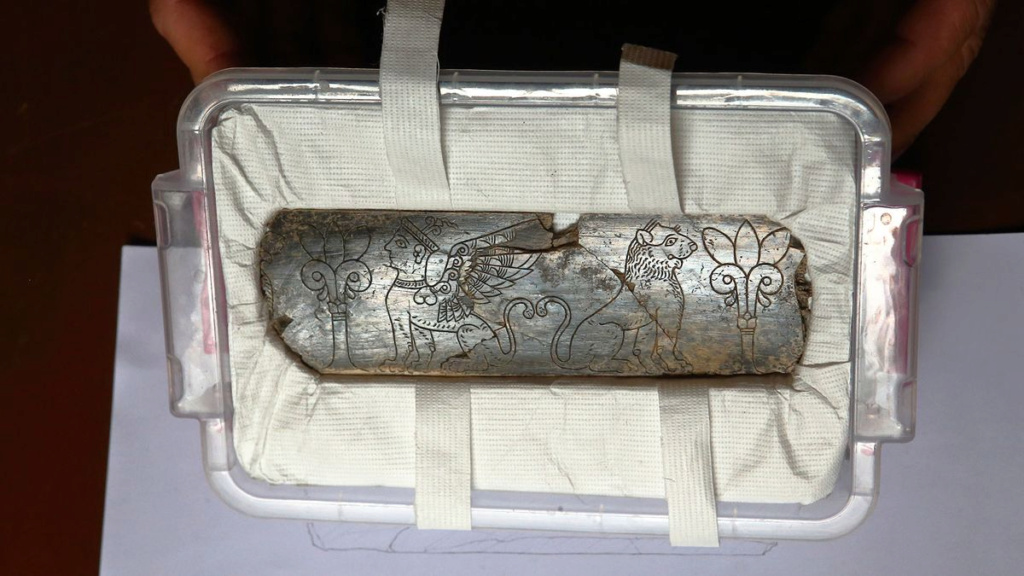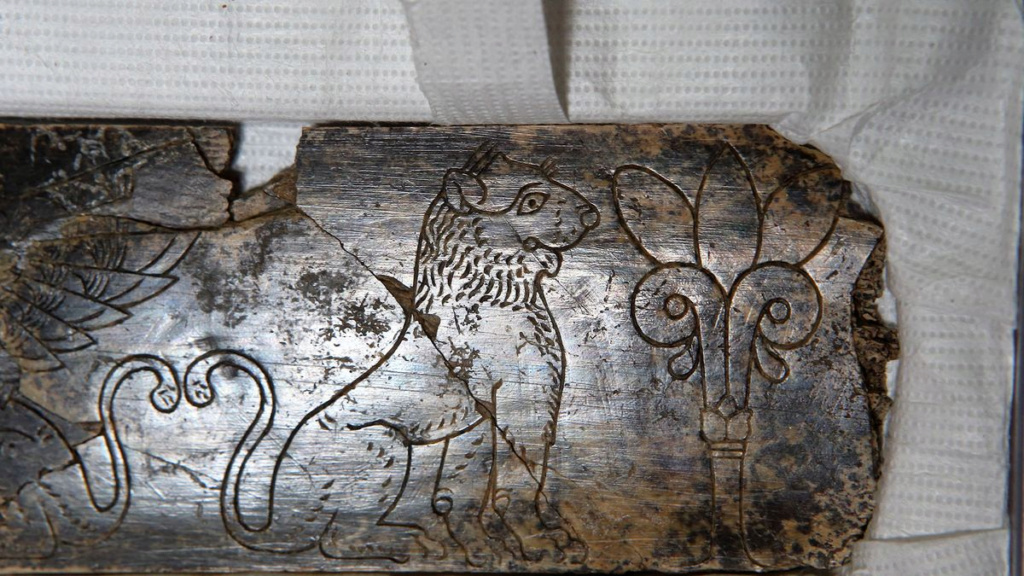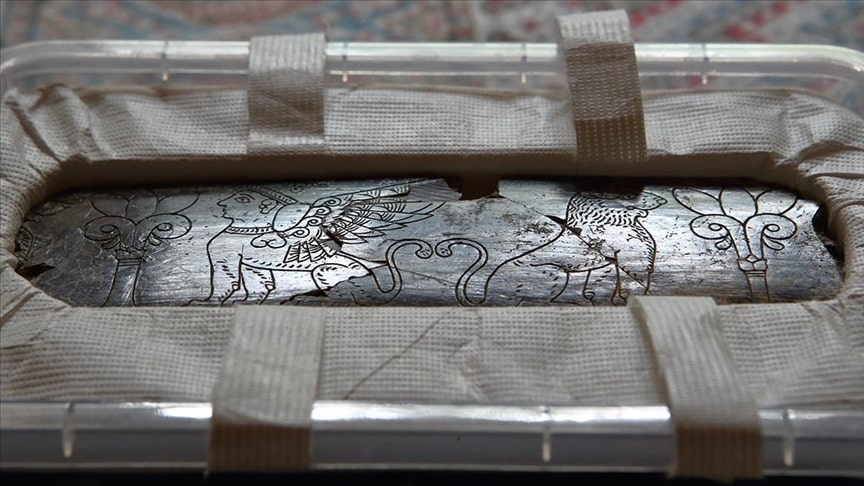An exceptional 2,800-year-old ivory, engraved with a sphinx and a lion, discovered in Hattusa, an ancient Hittite city in Turkey

During excavations at Hattusa, a fragment of Iron Age ivory was discovered, depicting complex artistic designs. This piece, unique in its kind, reveals extensive cultural links and symbolic richness of the period. It sheds new light on artistic exchanges and influences between ancient civilizations, thus enriching our understanding of the historical and cultural dynamics of the region.
In the heart of Turkey, in the remains of Hattusa, the ancient capital of the Hittite empire, a campaign of archaeological excavations has brought to light a historic treasure: a fragment of ivory dating back 2,800 years. This exceptional piece, decorated with a sphinx and a lion, opens a fascinating window into the art and culture of the Iron Age, a key period in human history. This vestige, revealed by the Turkish public agency Anadolu, a precious witness to a bygone era, raises questions about the cultural influences and artistic traditions of the region. Its discovery represents a significant milestone in the understanding of ancient history, offering new insight into the cultural interactions and developments that shaped the ancient world.
A unique ivory from the Hittite era
The ivory fragment discovered at Hattusa is an exceptional piece of art, due to its dimensions and the quality of its work. Measuring almost 30 centimeters, it was probably part of a larger object.
What is most striking is the finesse of its sculpture. The meticulous details of the sphinx and lion, iconic figures in many ancient cultures, demonstrate advanced artistic craftsmanship. The sphinx, with a human head on the body of a winged lion, often symbolizes protection and wisdom. The lion, on the other hand, is a universal symbol of strength and royalty. The presence of these two figures together on the same object suggests a link with power or spirituality.

The two trees of life add another dimension to the work. This motif symbolizes growth, fertility and the connection between the earthly and spiritual world. Their inclusion in the sculpture reinforces the idea of a work loaded with multiple and deep meanings.
Ivory, artistic witness of its time
This fragment of ivory could have adorned a wooden piece of furniture or a box. This hypothesis is based on the size and shape of the object, as well as common artistic practices of the time.
Ivory was a material prized for its durability and beauty. In ancient civilizations, it was often reserved for decorating objects of great value, signifying status and wealth. Thus, the fragment could have been part of a prestige object. It might be a box intended to keep precious objects or important writings. It could also be a decorative element of high quality furniture.
Despite the damage suffered, the preservation of the artifact is remarkable. The intact details allow archaeologists to reconstruct an image of its original form. The ivory carving technique of the period reveals a great level of skill and sophistication of the artisans.

Hattusa, a center of Hittite power and cultural exchange
Hattusa was once located at the crossroads of ancient trade routes. It was the capital of the Hittite Empire from around 1600 until around 1200 BCE. It therefore played a crucial role as a political and cultural center. This strategic position has made the city a meeting point for various cultures and civilizations.
The discovery of ivory in the Hattusa fortress is a testimony to this centrality. The city's fortifications, designed for its defense, also surrounded a vibrant center of commercial and artistic activities. It was not a simple stronghold, but a place for the exchange of ideas, goods and art.
As proof, the patterns engraved on the ivory fragment reflect the extent of Hattusa’s cultural interactions. The sphinx and the lion are recurring motifs in the art of many civilizations, particularly in Greece and the Middle East. Ideas and beliefs were shared and adapted along trade routes.
The Hittites, known for their multicultural empire, often incorporated elements of conquered cultures into their own society. The presence of these motifs on an object found in Hattusa is particularly significant. Local artisans were not only exposed to foreign influences, but also incorporated them into their work. They have created a style unique to this cosmopolitan city.

An ivory, a true link between the eras
The discovery of the ivory artifact at Hattusa, in a layer dating from the Iron Age, is particularly revealing about the historical and cultural evolution of the region. This fragment, found among the remains of an older Hittite city, reflects a period of transition in human history. The transition from the Bronze Age to the Iron Age.
This transition is marked by major changes in manufacturing techniques, tools used, and preferred materials. The Iron Age, as its name suggests, is characterized by the increased use of iron. It is a harder and more durable material than bronze. This development has had a profound impact on societies, ranging from war to agriculture and crafts.
The ivory artifact, with its complex patterns and fine craftsmanship, illustrates the adaptation and artistic innovation that accompanied these technological changes. Even as materials and techniques evolved, artistic and cultural traditions continued to develop. They adapted to new realities while preserving certain aspects of previous eras.
Not to mention that this discovery echoes the recent discovery of clay tablets revealing an unknown ancient language, Kalašma. It reinforces this perspective of a rich history of Anatolia in the Bronze Age. Also from the Boğazköy-Hattuşa excavations, it reveals a complex cultural and linguistic coexistence within the Hittite empire.
The presence of the ivory object in the Iron Age layers then suggests a certain continuity in the occupation and use of urban space in Hattusa. Despite political and cultural changes, the city continued to be an important center. It has retained its role as a crossroads for cultural exchanges and interactions.
Source: Turkish public agency Anadolu

